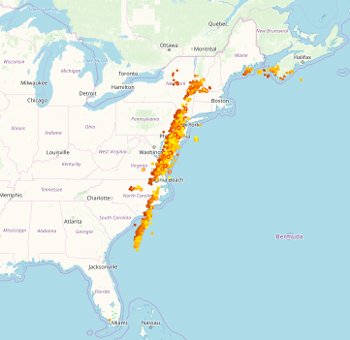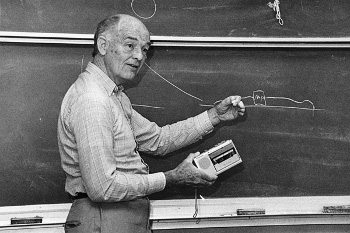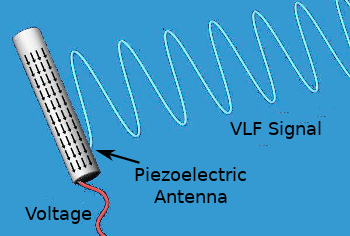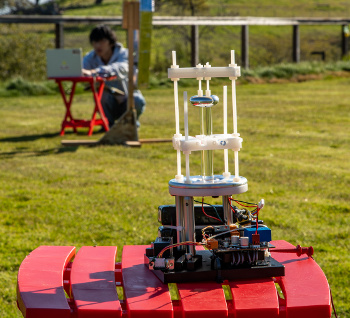Very Low Frequencies
May 27, 2019
I've been interested in
electronics since my
childhood. One of my favorite "
toys" was the
battery/
push-button/
doorbell kit that my
parents gave me when I was in
fifth grade. I used the large battery to make a variety of
electromagnets for other
experiments. Thin strands of
wire made good
electrical detonators for the
percussion caps used in
toy cap guns.
Although the
transistor and I were
born at nearly the same time, all my early
electronic circuits were made from
vacuum tubes and
components donated by a
neighbor who repaired
televisions.
Guitar amplifiers were popular items in the
1960s, so I built several for my friends using components harvested from derelict televisions.

Symbols for vacuum tubes. From left to right, a diode, tridode, tetrode, and pentode. The 12AX7 dual triode was my favorite tube for low-noise microphone preamplifiers. (Click for larger image.)
Useful
information was hard to obtain in those days before the
Internet. My electronics
education came from reading the
hobby electronics
magazine,
Popular Electronics, that had a monthly
printing of several hundred thousand copies, and two other magazines,
Radio-Electronics and
Electronics World.
Don Lancaster was a prolific
author of articles in these magazines, and he was also the author of two of my favorite
books, the TTL Cookbook,[1] and the CMOS Cookbook.[2] Don Lancaster published an article on construction of a
color organ, that era's version of a
laser light show, in April, 1963. I built a variation of that circuit a few years later, and I published a more modern version last year.[3]
Eventually,
audio frequency transistors became available to electronics
hobbyists at reasonable
prices. One of the first transistor circuits that I built was a
radio receiver for
frequencies in the 100-15,000
hertz frequency range. That was not because there were any
broadcast stations on those frequencies in the ELF (
extremely low frequency, <3 kHz) and VLF (
very low frequency, 3 - 30 kHz)
bands, but because there are
natural electromagnetic emissions called
radio atmospherics.
These radio atmospherics, often called
sferics or
spherics, are generated by
lightning discharges, and they
propagate over long distances by channeling in a
natural waveguide formed between the
Earth's surface and the
ionosphere. It's easy to see how such low frequencies are generated, since the
current path in a lightning discharge is several
miles in length. One interesting VLF
phenomenon is the
dawn chorus, radio emissions at audio frequencies that occur near
dawn at local time and resemble
bird chirps. The dawn chorus is supposed to arise through interactions between
electrons in
Earth's magnetosphere and the VLF background radiation.
Another VLF phenomenon is the
whistler, a
Doppler-shifted signal of descending frequency caused by
dispersion of the radio signals as they travel through ionospheric and magnetospheric
plasma. Such whistlers persist for a few seconds, and their detection on
Jupiter by the
Voyager spacecraft indicated that Jupiter has lightning, also.
Anyone who listens to
AM radio during a
thunderstorm knows that individual lightning strikes are readily detected using radio. This is especially true for VLF. It's been proposed that 13.6 kHz, a frequency at the edge of a
radionavigation band, should be reserved for this purpose. Lightning detection
technology has progressed considerably in the half
century since I built my VLF radio.
Blitzortung.org is an Internet-connected network community of about 500 people with advanced VLF receivers. Detected lightning strikes are
timestamped using
GPS receivers, and this allows an accurate
triangulation of the lightning strike location.

Lightning strikes along the Eastern United States near 4:00 AM on April 15, 2019.
This map was generated by the VLF receivers of the blitzortung.org project.
(Lightning data by blitzortung.org and contributors, licensed under the Creative Commons Attribution-ShareAlike 4.0 License. Click for larger image.)
Natural radio sources are not the only signals detected at VLF. When I built my VLF receiver, I detected signals from every
electric motor in my
neighborhood and the
ignition systems of passing
automobiles. All these devices generate
electrical sparks and simulate lightning discharges. One VLF pioneer,
Robert A. Helliwell (1920-2011), who discovered whistlers with one of his students, Jack Mallinckrodt, decided that locating a remote VLF station in
Antarctica would be a way to eliminate such
man-made interference.[4] I wrote about Helliwell in an
earlier article (Robert A. Helliwell, June 16, 2011).

VLF pioneer, Robert A. Helliwell
Helliwell's discovery of VLF whistlers was accidental.
Karl Jansky observed lightning noise in his experiments that resulted in the discovery of the first extraterrestrial radio source in 1933.
(Stanford University Image.)
This West Antarctic VLF outpost, called
Siple Station, was active from 1971-1988, and it had an
antenna that was thirteen miles long. The reason for this huge length is the long
wavelength of VLF radiation. A frequency of 10 kHz corresponds to a wavelength of 30
kilometers, or 18.64 miles. The antenna was used to inject VLF radio signals into Earth's magnetosphere, to be detected half a world away in
Canada. This was possible, since the ionosphere is transparent to such low frequencies, a principle that
Grote Reber used in his
Tasmanian radio astronomical observations.
There's an
adage that "You can't fool Mother Nature," made memorable in a
1974 margarine commercial.[5] Conventional antennas are
efficient only when their size is near the target wavelength. That's because the
electric field intensity in antenna
conductors increases in value to about half a wavelength. That's why the commonly used
dipole antennas are a half wavelength wide, and you would expect a VLF dipole antenna to be huge. A team of
scientists from the
SLAC National Accelerator Laboratory (Menlo Park, CA),
Gooch and Housego, LLC (Highland Heights,Ohio), a
photonics technology firm, and
SRI International (Menlo Park, California) have shown that it is possible to fool Mother Nature by creating efficient VLF antennas of much smaller size using a
piezoelectric antenna. Their
research is published in an
open access article in
Nature Communications.[6-7]
VLF signals are desirable for
communication, since they penetrate tens of meters into
soil or
seawater, and the signal
attenuation is ≤6
dB/1000 km within the Earth-ionosphere waveguide.[6] This is in contrast to shorter wavelength signals that are easily blocked by water, layers of
rock and
building structures, don't bend well over the
horizon, and are sometimes limited in range to
line-of-sight.[7] The piezoelectric
lithium niobate electric dipole antennas in the present study are about 10
cm in size, and they are driven at an
acoustical resonance that allows radiation at more than 300 times the expected efficiency for their size.[6]

Conceptual diagram of the piezoelectric VLF antenna.
The antenna consists of a rod-shaped crystal of lithium niobate. An oscillating voltage applied to the bottom of the rod makes it vibrate.
This mechanical stress triggers an oscillating electric current (shown by the arrows), its electromagnetic energy being emitted as VLF radiation (blue waves).
(Image by Greg Stewart/SLAC National Accelerator Laboratory (modified). An animated version can be found here.)
When an oscillating electric voltage is applied to the lithium niobate rod, it vibrates because of the
piezoelectric effect, alternately shrinking and expanding. This mechanical stress creates an
oscillating electric current whose
electromagnetic energy is emitted as VLF radiation.[7] In conventional antennas, the electric current arises from the motion of electric charges moving the length of the rod, and these motions are of the same scale as the wavelength. The piezoelectric antenna efficiently excites electromagnetic waves with wavelengths that are much larger than the motions along the crystal.[7] By adjusting the piezoelectric resonance, the wavelength can be changed to transmit signals in a wider
bandwidth that allowed
data transfer rates of more than 100
bits per second.[7]
The new antenna's compact size will enable VLF
transmitters that weigh just a few
pounds. Experimental communication over a hundred foot distance showed that the VLF radiation was produced at 300 times greater efficiency than conventional antennas and with nearly a hundred times greater bandwidth.[7] Says
Mark Kemp of SLAC, the
principal investigator of this project,
"Our device is also hundreds of times more efficient and can transmit data faster than previous devices of comparable size... Its performance pushes the limits of what's technologically possible and puts portable VLF applications, like sending short text messages in challenging situations, within reach."[7]

The piezoelectric VLF antenna, the 4-inch length clear rod at the center of the assembly, during testing.
(Photo by Dawn Harmer/SLAC National Accelerator Laboratory.)
Says Kemp, "There are many exciting potential applications for the technology... Our device is optimized for long-range communication through air, and our research is looking at the fundamental science behind the method to find ways to further enhance its capabilities."[7] This research was funded by the
Defense Advanced Research Projects Agency (DARPA), and a
patent is pending on this
invention.[7]
References:
- Don Lancaster, "TTL Cookbook," Sams Publishing; 1st edition (March 11, 1974), 336 pp., ISBN: 978-0672210358 (via Amazon).
- Don Lancaster, "CMOS Cookbook," Sams Publishing; 1st edition (1977), 414 pp., ISBN: 978-0672213984 (via Amazon).
- Devlin Gualtieri, "Build an Audio Response Light Display: Modern LEDs in Action," Circuit Cellar, Issue #337 (August 2018), p. 6.
- Melissae Fellet, "Robert Helliwell, Radioscience and Magnetosphere Expert, Dead at 90," Stanford Report, May 20, 2011.
- Chiffon Ad (1974), YouTube Video by Chuck D's All-New Classic TV Clubhouse, July 30, 2016.
- Mark A. Kemp, Matt Franzi, Andy Haase, Erik Jongewaard, Matthew T. Whittaker, Michael Kirkpatrick, and Robert Sparr, "A high Q piezoelectric resonator as a portable VLF transmitter," Nature Communications, vol. 10, no. 1 (April 12, 2019). Article no. 1715, https://doi.org/10.1038/s41467-019-09680-2. This is an open access article with a PDF file here.
- Manuel Gnida, "SLAC develops novel compact antenna for communicating where radios fail," Stanford University Press Release,April 12, 2019.
Linked Keywords: Electronics; childhood; toy; battery (electricity); push-button; doorbell; electronic kit; parent; fifth grade; electromagnet; experiment; wire; electrical detonator; percussion cap; toy cap gun; transistor; birth; born; electronic circuit; vacuum tube; electronic component; neighborhood; neighbor; television set; guitar amplifier; 1960s; vacuum tube diode; tridode; tetrode; pentode; 12AX7; low-noise; microphone; preamplifier; information; Internet; education; hobby; magazine; Popular Electronics; print run; Radio-Electronics; Electronics World; Don Lancaster; author; book; color organ; laser light show; audio frequency; hobby; hobbyist; price; radio receiver; frequency; hertz; radio broadcasting; broadcast station; extremely low frequency; very low frequency; radio spectrum; band; nature; natural; electromagnetic radiation; electromagnetic emission; radio atmospheric; lightning discharge; radio propagation; Earth-ionosphere waveguide; natural waveguide; lithosphere; Earth's surface; ionosphere; electric current; mile; phenomenon; dawn chorus (electromagnetic); dawn at local time; bird vocalization; bird chirp; electron; Earth's magnetosphere; whistler (radio); Doppler effect; dispersion (optics); plasma (physics); Jupiter; Voyager program; Voyager spacecraft; AM broadcasting; AM radio; thunderstorm; radionavigation; technology; century; Blitzortung.org; timestampe; GPS receiver; triangulation; Lightning strikes along the Eastern United States near 4:00 AM on April 15, 2019; lightning strike; Eastern United States; Creative Commons Attribution-ShareAlike 4.0 License; electric motor; neighborhood; ignition system; automobile; electrical spark; Robert A. Helliwell (1920-2011); Antarctica; electromagnetic interference; man-made interference; VLF whistler; serendipity; accidental; Karl Guthe Jansky; lightning; noise (electronics); experiment; Sagittarius A; first extraterrestrial radio source; Stanford University; Siple Station; antenna (radio); wavelength; kilometer; Canada; Grote Reber; Tasmania; radio astronomy; adage; 1974 margarine commercial; energy conversion efficiency; efficient; electric field; intensity (physics); electrical conductor; dipole antenna; scientist; SLAC National Accelerator Laboratory (Menlo Park, CA); Gooch and Housego, LLC (Highland Heights,Ohio); photonics; SRI International (Menlo Park, California); piezoelectricity; piezoelectric; research; open-access journal; open access article; Nature Communications; communication; soil; seawater; attenuation; decibel; dB; rock (geology); building structure; horizon; line-of-sight propagation; lithium niobate; centimeter; cm; acoustics; acoustical; resonance; concept; conceptual; diagram; crystal; oscillation; oscillating; voltage; vibration; mechanical stress; electric current; electromagnetism; electromagnetic; energy; electromagnetic radiation; Greg Stewart; piezoelectric effect; energy; bandwidth; data; bit rate; bits per second; transmitter; pound; Mark Kemp; principal investigator; Dawn Harmer; DARPA; Defense Advanced Research Projects Agency; patent; invention; TTL Cookbook; CMOS Cookbook.